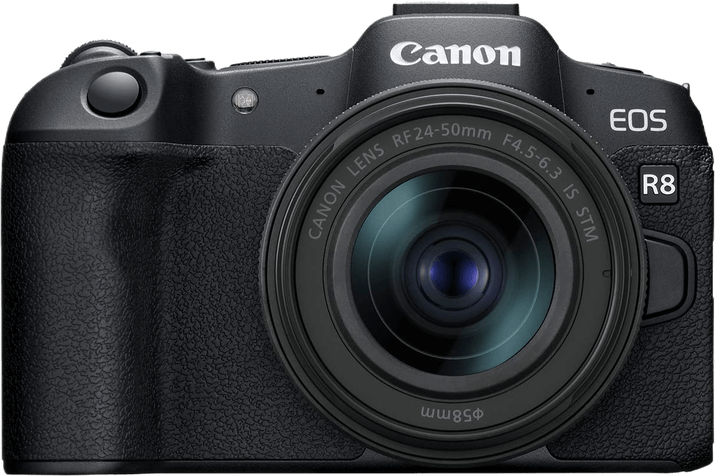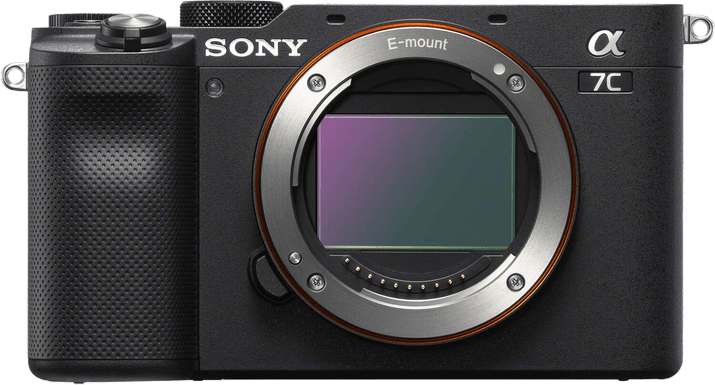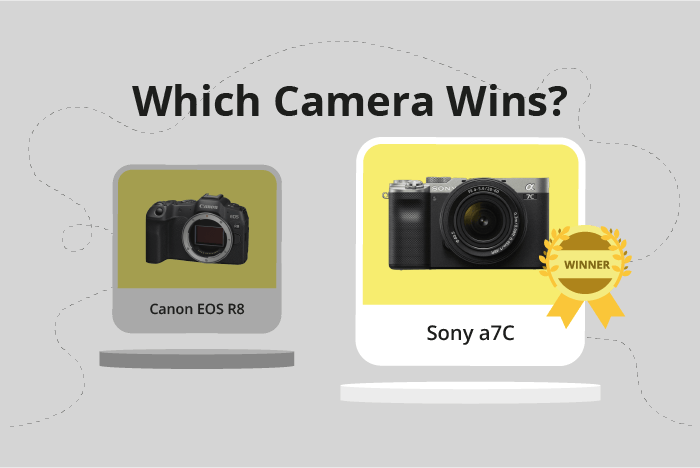Canon EOS R8 vs Sony a7C Comparison
Canon EOS R8

Sony a7C

The Canon EOS R8 and Sony a7C are both mirrorless cameras, with the Sony a7C slightly ahead with a score of 78/100, compared to the Canon EOS R8’s 76/100. They share similarities in camera type and release years, 2023 and 2020 respectively.
The Canon EOS R8 is more affordable at $1499, and lighter at 461g (1.02lbs). Its dimensions are 133 x 86 x 70mm. On the other hand, the Sony a7C is priced higher at $1799 and weighs more at 509g (1.12lbs), but it is smaller with dimensions of 124 x 71 x 60mm.
Taking into account the scores, price, weight, and dimensions, the Sony a7C is the better camera, despite being more expensive and heavier. However, the Canon EOS R8 offers a more budget-friendly option without compromising too much on quality.
Canon EOS R8 vs Sony a7C Overview and Optics
The Sony a7C wins the optics comparison with a score of 80/100, while the Canon EOS R8 scores 77/100. Both cameras share several common specifications, including 24-megapixel full-frame CMOS sensors, compatibility with their respective lens mounts (Canon RF and Sony FE), and processors (Digic X for Canon and Bionz X for Sony).
The Sony a7C outperforms the Canon EOS R8 in a few key areas. Firstly, it has a slightly higher DXOMARK sensor score of 95 compared to the R8’s 94, which means the a7C’s sensor produces better image quality. Secondly, the a7C includes built-in image stabilization, a feature absent in the R8. Image stabilization helps reduce camera shake, resulting in sharper images, especially in low-light situations or when using longer lenses.
On the other hand, the Canon EOS R8 has an advantage in shooting speed, capable of capturing 40 frames per second (fps) compared to the a7C’s 10 fps. This makes the R8 more suitable for action photography or situations where fast capture is essential.
In terms of optics, the Sony a7C emerges as the better camera due to its higher sensor score and the presence of image stabilization. However, the Canon EOS R8’s faster shooting speed may appeal to photographers who require rapid capture capabilities. Ultimately, the choice between these cameras will depend on individual preferences and specific photography needs.
Canon EOS R8 vs Sony a7C Video Performance
The Canon EOS R8 emerges as the winner in the video capabilities comparison with a score of 91, while the Sony a7C follows with a score of 70 – a difference of 21 points. Both cameras share some common video specifications, such as 4K maximum video resolution and 3840 x 2160 maximum video dimensions. Additionally, both the Canon EOS R8 and Sony a7C have built-in time-lapse functionality.
The Canon EOS R8 surpasses the Sony a7C in terms of maximum video frame rate, offering an impressive 180fps, which allows for smooth slow-motion capture and greater creative flexibility. This higher frame rate is a significant advantage for those interested in capturing fast-paced action or cinematic footage.
On the other hand, the Sony a7C’s maximum video frame rate is limited to 30fps, which may be sufficient for general use, but lacks the versatility and creative potential offered by the higher frame rate of the Canon EOS R8. Despite this limitation, the Sony a7C still delivers high-quality 4K video and time-lapse functionality, making it a capable camera for those with less demanding video requirements.
Taking into account the differences in video capabilities, the Canon EOS R8 is the clear choice for videographers seeking advanced features and superior performance, such as the 180fps frame rate. Meanwhile, the Sony a7C remains a viable option for users who prioritize other aspects of camera performance and do not require the additional video capabilities offered by the Canon EOS R8.
Canon EOS R8 vs Sony a7C Features and Benefits
The Canon EOS R8 outperforms the Sony a7C with a feature score of 85/100, compared to the Sony a7C’s score of 81/100. Both cameras share several specifications, including a 3-inch screen size, touchscreen capability, flip screen functionality, and the absence of GPS. Additionally, both have WIFI and Bluetooth connectivity.
The Canon EOS R8 takes the lead with its superior screen resolution of 1,620,000 dots, compared to the Sony a7C’s 921,600 dots. This higher resolution provides clearer and sharper images, making it easier for photographers to review their shots and make adjustments accordingly. This advantage plays a significant role in the Canon EOS R8’s higher feature score.
On the other hand, the Sony a7C has its merits. Although it does not surpass the Canon EOS R8 in any specific feature, its slightly lower score implies that it is still a competitive option in the market. The Sony a7C may excel in other aspects not mentioned in this comparison, such as size, weight, or pricing. These factors could influence the final decision of potential buyers.
Considering the feature scores and shared specifications, the Canon EOS R8 is the better choice for those prioritizing screen resolution. However, the Sony a7C remains a viable option for photographers who may value other factors beyond the scope of this comparison. Ultimately, the best camera for an individual depends on their specific needs and preferences.
Canon EOS R8 vs Sony a7C Storage and Battery
The Sony a7C outperforms the Canon EOS R8 in storage and battery with a score of 45/100 compared to 35/100. Both cameras have one memory card slot and support USB charging. They also accept SD, SDHC, and SDXC memory cards. However, the Sony a7C is compatible with faster UHS-II cards, while the Canon EOS R8 only supports UHS-I and II cards.
The Sony a7C has a significant advantage in battery life, offering 740 shots per charge compared to the Canon EOS R8’s 370 shots. This longer battery life makes the Sony a7C more suitable for extended shooting sessions. The Canon EOS R8’s only advantage in this category is its compatibility with both UHS-I and II cards, offering more flexibility in memory card choice. However, this advantage is minimal, as the faster UHS-II cards are more desirable for high-performance photography.
Ultimately, the Sony a7C is the superior choice in terms of storage and battery life, making it the better option for photographers who require extended shooting capabilities and faster memory card performance.
Canon EOS R8 vs Sony a7C – Our Verdict
Are you still undecided about which camera is right for you? Have a look at these popular comparisons that feature the Canon EOS R8 or the Sony a7C:

